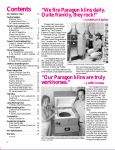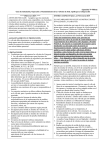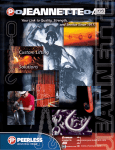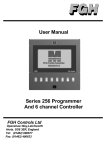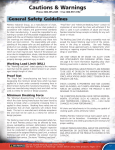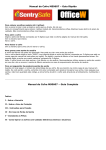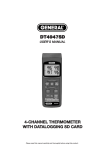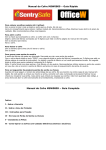Download a pdf - Hawaii Potters` Guild
Transcript
Table of Contents The LiteLid Support Loading the Kiln Venting …………………………………………………………………………….........2 …………………………………………………………………….…...............2 – 3 .….……………………………………………………………………………………………………….3 To Start Kiln …………………………………………………………………………………………………4 Firing Completion ………………………………………………………………………………………….4 When Can You Unload the Kiln? Vacuuming the Kiln ……………………………………………………………………………………….5 Vacuuming Digital Kilns Bisque Firing the Kiln ……………………………………………………..…........5 ……………………………………………………………………………….5 ……….………………………………………………………………………….6 Bisque / Cone Fire Program, e.g., cone 06 …………….…………………………………….7 Cone 06 Bisque Firing Program Review …………………………………………………………8 Glaze / Cone Fire Program, e.g. cone 10 ………………………………….…………………..9 Cone 10 Glaze Firing Program Review ……………….………..……………………………..10 Select and Fire a Stored User Program, e.g., crystalline glazing.......……11 Crystalline Glaze Firing User 1 Program Review …….……………………………12 Ramp Hold Program, e.g., crystalline glaze firing user 1 program ..........13 1 Paragon Guidelines Revised 9-14-13 The LiteLid Support Begin raising the lid using the center lid handle. When the lid feels weightless, hold a side lid handle with your other hand to guide the lid the rest of the way up. Do not let go of the side lid handle until the lid reaches its fully opened position. Otherwise, the lid could slam upward, damaging the firebricks near the hinge and even possibly damaging the hinge itself. Loading the Kiln 1) Work slowly and carefully. Treat the kiln as if it were a piece of fine furniture that you don’t want to scratch. Don’t touch the firebrick walls if you can help it. 2) Check each shelf for cracks and don’t use any that are severely cracked. One of the secrets to keeping your kiln in good condition is in the way you hold the shelves when you load the kiln. Tilt the shelf as you lower it into the kiln. Center it so it doesn’t touch the kiln walls. At all times, be aware of the location of the digital thermocouple so that you avoid bumping the shelf against it. 3) Start with 1” posts on floor before placing the first shelf. Do not place shelves face to face at the middle. Leave a 1” gap between shelves to allow for air circulation and better radiant heat distribution. Maintaining this 1” gap between shelves is necessary for the entire load. 4) Never place a shelf level with a heating element. Shelves must be stacked so there is at least one row of heating elements between any two shelves 5) The posts being used should be 1” taller than the ware, e.g., a piece 3” tall should use a 4” post. 6) Be sure that all greenware being loaded is bone dry. If it feels cool on your cheek, then it’s not ready to fire. 7) Ordinarily, load pieces of medium height on the bottom shelf and tall pieces on the top shelf. When firing pieces of varying heights on the same shelf, the tall pieces should go in the center. This is to avoid blocking radiant heat from reaching the shorter pieces. 8) Wide bottom pieces will fire best if placed across two half shelves positioned at an even height and in the middle of the kiln. If the shelves are uneven, use either pieces of soft brick, small dry clay balls, pencil-sized strands of clay or grog under the ware. Or use a large single shelf to place across the two half shelves. Do not stack plates or other work on anything with a wide base. 2 9) Elevating large tiles & slabs will allow air and heat to circulate around them for even heating and also so moisture can escape, thereby reducing tile warpage and cracking. If you choose to do so, use supports placed 1” in from the edge at the four corners of the slab. Any tiles or slabs that are larger than 6” x 6” should use five supports: 1” in from each corner and one in the middle. Grog is also a proven theory to help aid with movement due to expansion and contraction if the slab is placed directly on the shelf. Do not stack tiles or slabs, or place other work on top of them. 10) Heavy bottom pieces or thick ware should be placed in the center of the kiln, away from the elements. If it’s possible to do so, they should also be elevated on pieces of soft brick or 1” posts to allow moisture to escape from the bottom. 11) Keep all ware at least 1” away from a heating element. If ware extends closer than 1” to a wall, place it between rows of elements. 12) Keep all ware and kiln shelves at least 1” away from the side, top and bottom of the end of the digital thermocouple. However, HPG members prefer to stack below and above the blue marked section around the thermocouple. 13) Make sure at least one element groove is between the top shelf and the top of your kiln. The top of ware should be at least 1” lower than the lid. 14) Do not leave lid standing open, close lid gently at the end of loading or use the Prop-R-Vent until ready to fire. Using the Prop-R-Vent displaces the stress from the cover being open to the frame. Using a post or brick to prop the cover displaces the stress to the cover itself. 15) The lid is made up of soft brick and is only held together by the metal band that surrounds the lid. Never place anything on top of the lid. 16) Each kiln has a folder which contains a “Paragon Firing Record” form. Please document all activity. 17) As a courtesy, if you break someone’s work while loading or unloading (or at anytime), leave a note of apology with your name. Venting Firing the ware too fast and with insufficient venting causes more problems than any other firing practice. The Orton Vent Master Fan used with our downdraft vent design requires that the lid be closed and the peephole plugs inserted throughout the firing. 3 To Start Kiln 1) Never fire the two kilns at the same time. If the Prop-R-Vent is in use, close the cover, plug peep holes and turn on the Orton Vent Master Fan. Timers for the fans have been installed and will shut off automatically. Instructions for the timers are located by the electrical outlet plug in switch. 3) Move the lever on the shut off box to the “on” position. Wait until both “Idle” and “Kiln Temperature” flash on the display panel before proceeding. From this point, you can access either the CONE-FIRE PROGRAM, (on page 7 for bisque or on page 9 for glaze) or the RAMP-HOLD PROGRAM, (on page 13). 4) Before every firing, it is critical that the “PROGRAM REVIEW” is double checked. Whoever starts the kiln is responsible for double checking the “PROGRAM REVIEW” (press key #6) to ensure the current program is correct. 5) Each kiln has a folder which contains a “Paragon Firing Record”. Please document all activity. Firing Completion Keep a record of every firing by using the “Paragon Firing Record”. After the kiln has fired to completion, the display will flash “CPLT” along with the length of the firing time, the temperature reached and the present temperature inside the kiln: 1) Record the length of the firing time and the temperature reached. 2) Press the “Stop/Back” button to end the present program. 3) Press “Firing Cost” (#8 on key board), to view and record the kilowatts used. (Only kiln #2 has this feature) 4) After recording all the information from the program, move the lever on the shut off box to the “off” position. 5) After the kiln has completed the firing and shut off, leave the Orton Vent Master Fan on for at least another 30 minutes. This is because even though the ware has fired to temperature, it still releases fumes. 6) Place ceramic plaque, “COOLING” DON’T OPEN YET on kiln. 4 When Can You Unload the Kiln? Refer To: “Paragon Ceramic Kiln Instruction and Service Manual” page 4, column 2, point #5: Do not open the lid until kiln has cooled to room temperature and all switches are off page 5, column 1, point #2: Do not remove the ware from the kiln until the kiln has cooled to room temperature. 1) Move the lever on the shut off box to the “on” position. Wait until both “Idle” and “Kiln Temperature” flash on the display panel. When the kiln has cooled to room temperature, (+/-80º) move the lever on the shut off box to the “off” position before proceeding. 2) Open the lid by following the procedure outlined in The LiteLid Support on page one. Do not leave lid standing open, close lid gently at the end of unloading. 3) Anything of importance should be documented on the “Paragon Firing Record” form, e.g. incorrect loading, explosions, faulty firing, PF2 flashing on the display or any and all error messages, etc. Vacuuming the Kiln Wear a mask to avoid breathing brick dust. Check all holes on top of kiln cover and bottom of floor to make sure it’s clear of all debris. Use a vacuum cleaner with a soft brush nozzle to remove brick dust from inside the kiln, starting from the inner surface of the kiln lid and working your way to the bottom. Vacuuming the element grooves is essential if anything has exploded inside the kiln. Pieces of greenware and brick dust that lodge inside the grooves can burn out an element. Document all activity on the “Paragon Firing Record” form by filling out the section for vacuuming the kiln. Vacuuming Digital Kilns Check to make sure that the lever on the shut off box is in the “off” position before vacuuming. A static electric charge can build up on the vacuum hose especially in dry weather. Static electricity can damage electronics. Keep the vacuum away from the digital controller, the switch box, and the thermocouple tip that extends into the firing chamber. 5 BISQUE FIRING THE KILN The Stages of Firing A fast greenware firing does not save time, energy or money if it causes explosions, glaze crazing, pinholes or cratering. The thicker the ware and the more densely packed the kiln, the slower the kiln must fire to insure that the heat reaches all of the ware. Pieces that have thin and thick areas must also be fired slowly to allow the thick areas to catch up in temperature with the thin areas. Stage One: Water Smoking – Up to 800-900ºF All clays contain both physical and chemical water. As the water heats, it expands and is pushed out of the clay. This is called water smoking. Fast firing during this stage can lead to disaster. Water boiling inside the clay will explode, damaging not only the ware but also the walls of the kiln. Maintain temperature at 200ºF or lower during water smoking, and vent the kiln so that the water can escape. The temperature for the pre-heat stage of the firing is programmed by the manufacture for 200ºF. Stage Two: Dehydration and Quartz Inversion-900º-1100ºF At around 1060ºF, the clay goes through quartz inversion, which is the point at which the silica in the clay expands. Through 900º-1100ºF, the molecular water must exit the clay slowly, especially if the clay pieces are large. Stage Three: Oxidation-500º-2000ºF Impurities burn out of the clay from the very beginning of the firing, but especially during the Oxidation stage. The ware must be heated slowly to give impurities, such as carbon, enough time to become gases and combine with oxygen, The thicker the ware and the heavier the load, the slower the ware must be fired. As the clay reaches higher temperatures, the components of the clay fuse together, sealing the clay surface. At this point, remaining carbon and other impurities become trapped inside the ware. The trapped gases expand beneath the surface, bloating and cracking the ware. Glaze pinholes, bubbles, crazing and peeling are often cause by gases that had not burned out fully in the greenware firing. These gases are pushed to the surface during the glaze firing. The preferred bisque temperature at HPG is Cone 06 (1828ºF). Pre-heat and Firing Speed An 8 HR pre-heat at “STD” firing speed has proven to be the most successful firing schedule to follow. 6 BISQUE / CONE FIRE PROGRAM, e.g., cone 06 1) Cone fire programming will only be done by the kiln chair or a trained individual. 2) Any errors made with programming will default to a “FAST” firing speed setting. Greenware will not survive when bisque fired “FAST.” KEYS TO PRESS DISPLAY COMMENTS 1 CONE FIRE CONE Enter the cone number (e. g. 06) 06 06 Cone Temperature ENTER SPD Enter the firing speed 2 (MED) STD Standard firing speed ENTER PRHT Enter Pre-heat time 08.00 08.00 Pre-heat time ENTER HOLD Enter hold time 00.00 00.00 ENTER COOL 00.00 00.00 ______________________________________________________________ ENTER Enter slow cooling rate IDLE & TEMP (flashing) Kiln is now ready to fire 3) Before every firing, it is critical that the values entered are double checked. Press key #6, (“Program Review”) and refer to Cone 06 Bisque Firing Program Review on next page before proceeding. The check list for the bisque firing sequence will also be posted on the kiln controller for easy viewing. 7 CONE 06 BISQUE FIRING PROGRAM REVIEW The display should read: DELA 00.00 CONE 06 1828 STD PRHT 08.00 HOLD 00.00 COOL 00.00 IDLE & TEMP (flashing) KEYS TO PRESS DISPLAY COMMENTS ENTER/ START START Kiln is now firing ______________________________________________________________ 8 GLAZE / CONE FIRE PROGRAM, e.g. cone 10 1) Program operation will only be done by the kiln chair or a trained individual. 2) Follow all of the “Paragon Guidelines” previously outlined. 3) Vacuum the kiln before each glaze firing. 4) Be sure that the kiln shelves you are using are silicon carbide. 5) Cone 10 glaze firings will take place in February, May, August and November. 6) All glaze firings require three cone packs: top, middle and bottom KEYS TO PRESS DISPLAY COMMENTS ______________________________________________________________ 1 CONE FIRE CONE Enter the cone number (e. g. 10) 10 10 Cone Temperature ENTER SPD Enter the firing speed 2 (MED) STD Standard firing speed ENTER PRHT Enter Pre-heat time 00.00 00.00 Pre-heat time ENTER HOLD Enter hold time 00.00 00.00 ENTER COOL 00.00 00.00 ENTER Enter slow cooling rate IDLE / TEMP (flashing) Kiln is now ready to fire 7) Before every firing, it is critical that the values entered are double checked. Press key #6, (“Program Review”) and refer to Cone 10 Glaze Firing Program Review on next page before proceeding. 9 CONE 10 GLAZE FIRING PROGRAM REVIEW The display should read: DELA 00.00 CONE 10 2345 STD PRHT 00.00 HOLD 00.00 COOL 00.00 IDLE / TEMP (flashing) KEYS TO PRESS DISPLAY COMMENTS ENTER/ START START Kiln is now firing ______________________________________________________________ 10 SELECT AND FIRE A STORED USER PROGRAM, e.g., crystalline glazing 1) Program operation will only be done by the kiln chair or a trained individual. 2) Follow all of the “Paragon Guidelines” previously outlined. 3) Vacuum the kiln before each glaze firing. 4) Be sure that the kiln shelves you are using are silicon carbide. 5) All glaze firings require three cone packs: top, middle and bottom KEYS TO PRESS DISPLAY COMMENTS ______________________________________________________________ 4 RAMP HOLD 1 ENTER STOP USER USER 1 is for crystalline glaze firing 1 RA 1 / FULL IDLE / TEMP (flashing) Selected program is ready to fire 6) Before every firing, it is critical that the values entered are double checked. Press key #6, (“Program Review”) and refer to Crystalline Glaze Firing User Program Review on next page before proceeding. 7) The middle cone pack should be visible through middle peep hole. After about 4– 5 hours, cone 10 will bend to a 90º angle. The display temperature will show around 2300ºF (+/-). Watch the cone closely from this point on. 8) When cone 10 reaches a 90º angle, press key #9 (SKIP), then ENTER: This feature will allow the kiln to stop firing in RAMP 1 and begin firing in RAMP 2. This segment of the program allows the kiln to cool down to 1910ºF in approximately half-an-hour and hold this temperature for 4.30 hours. NOTE: Temperature will fluctuate during HOLD time 9) The user program will end here and turn off the kiln automatically. Allow kiln to cool naturally. Do not open cover, take out peeps or unload kiln until it has cooled to room temperature, about 80ºF (+/-). 11 Crystalline Glaze Firing User 1 Program Review The display should read: USER 1 DELA 00.00 RA 1 9999 / FULL F1 2345 HD 1 00.00 RA 2 9999 / FULL F2 1910 HD 2 04.30 IDLE / TEMP (flashing) KEYS TO PRESS DISPLAY COMMENTS ______________________________________________________________ ENTER / START START 12 Kiln is now firing RAMP HOLD PROGRAM, e.g., crystalline glaze firing user 1 program 1) Program operation will only be done by the kiln chair or a trained individual. KEYS TO PRESS DISPLAY 4 RAMP HOLD USER COMMENTS ______________________________________________________________ 1 ENTER 9999/FULL 1 Crystalline Glaze Firing RA 1 Enter temperature rate for Ramp 1 9999 / FULL ENTER F1 2345 2345 ENTER HD 1 00.00 00.00 ENTER RA 2 9999/FULL Enter target temperature for Ramp 1 Hold time for Ramp 1 Enter temperature rate of Ramp 2 9999 / FULL ENTER F2 1910 1910 ENTER HD 2 04.30 04.30 ENTER RA 3 00.00 00.00 ENTER Enter program number Enter target temperature for Ramp 2 Hold time for Ramp 2 Ramp 3 IDLE / TEMP (flashing) 13 END USER 1 PROGRAM














